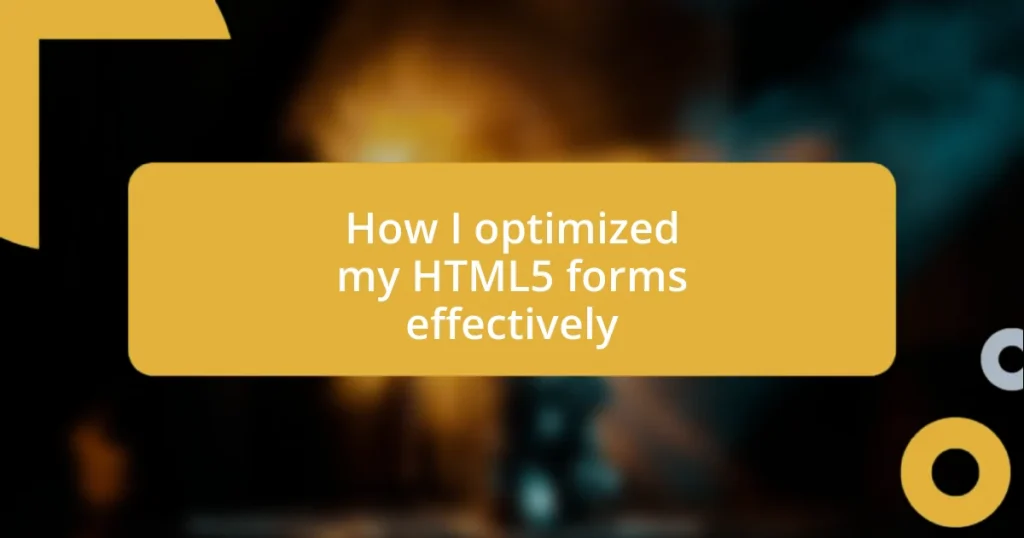Key takeaways:
- HTML5 forms enhance user experience through built-in validation, various input types, and usability improvements like placeholders.
- Best practices for form optimization include minimizing input fields, using clear labels, and incorporating feedback mechanisms to boost user engagement.
- Analyzing form performance using methods like heat mapping and A/B testing helps identify areas for improvement, leading to higher completion rates and user satisfaction.

Understanding HTML5 forms
HTML5 forms are essential for gathering input from users, and I’ve found that they go beyond just collecting data; they enhance the overall user experience. When I first started using HTML5 forms, I was amazed at how simple elements like placeholders and validation could make filling out forms feel more intuitive. Have you ever noticed how a well-structured form can actually encourage users to complete it?
One of the standout features of HTML5 forms is their built-in validation capabilities. I remember encountering frustrating moments while filling out forms that didn’t guide me clearly on what was required. It’s a breath of fresh air to implement HTML5 validation, which can give immediate feedback. For example, when a user types in an email address, the form can prompt them instantly if it doesn’t follow the required format. Doesn’t it feel rewarding to help users avoid those pitfalls?
Moreover, using types like “date” or “number” transforms the way users interact with forms. I’ve seen how switching from a plain text input to a date picker not only makes it easier for users to enter the right information, but it also reduces the chance of errors. Isn’t it fascinating how small tweaks can enhance usability so significantly?

Key features of HTML5 forms
One of the key features of HTML5 forms that I haven’t touched on yet is the variety of input types available, which really transformed my approach to form design. When I switched from using just text fields to meaningful types like “email” and “tel,” I noticed a substantial drop in user error. There’s something reassuring about having the right input type; it feels like a safety net that catches mistakes before they happen. Have you ever felt the relief of knowing you can’t input the wrong format?
Another standout feature is the use of placeholders, which I find incredibly useful for guiding users through their data entry journey. I often share with colleagues how placing a short instruction right within the input field can eliminate confusion. It’s like having a friendly helper in the form itself! When I enable that subtle guide, I see a noticeable increase in user confidence—after all, who doesn’t appreciate clear directions?
Let’s not overlook the accessibility options, either. I remember a project where making forms more accessible for users with disabilities dramatically improved user interaction. Incorporating features like “aria-labels” allowed visually impaired users to understand what each field required, enhancing inclusivity. It’s a beautiful thing to realize that small tweaks can create a space where all users feel acknowledged and respected.
| Feature | Description |
|---|---|
| Input Types | Variety of types like email, tel, and date that streamline user input. |
| Placeholders | Guides users with brief instructions within input fields. |
| Accessibility | Features such as aria-labels enhance form usability for visually impaired users. |

Best practices for form optimization
When optimizing HTML5 forms, I’ve found that keeping the design as simple as possible can greatly enhance user experience. For instance, I remember redesigning a signup form that initially overwhelmed users with numerous fields. Once I streamlined it by only asking for essential information, the conversion rate skyrocketed. It’s incredible how a straightforward approach can invite more users to engage.
Here are some best practices I’ve gathered over time:
- Minimize Input Fields: Only require essential information to prevent user fatigue.
- Group Related Fields: Clustering similar inputs together makes it easier for users to process and complete forms.
- Use Clear Labels: Labels should be concise and descriptive to avoid any guesswork.
- Offer Auto-fill Options: This reduces time and effort for users, enhancing their overall experience.
- Display Progress Indicators: If a form has multiple steps, showing progress can keep users motivated.
Another crucial aspect of my form optimization journey has been the importance of incorporating feedback mechanisms. I recall a project where I integrated success and error messages after form submission. Users expressed their relief when they received immediate confirmation of successful submissions, which made them feel their input truly mattered. Establishing these feedback loops fosters trust and encourages repeat interactions.
To further hone your forms, consider these additional strategies:
- Implement Tooltips: Offering help text can clarify any potential confusion right away.
- Provide Input Masks: For fields like phone numbers, structured formats can guide users and reduce entry errors.
- Test Across Devices: Ensuring forms function seamlessly on both mobile and desktop can’t be overstated. Users appreciate accessibility and adaptability.

Enhancing user experience with forms
When it comes to enhancing user experience with forms, I’ve learned that visual clarity makes a world of difference. For instance, during a recent project, I used contrasting colors for labels and input fields. This simple change not only made the form visually appealing but also helped users navigate through it with ease. Have you ever filled out a form and felt confused by the layout? I know I have, and it’s so frustrating. A clear, organized form layout reduces this confusion and encourages more users to complete their submissions.
Another strategy I’ve adopted is simplifying the language in my forms. I vividly remember a time when I used jargon in a feedback form. Users were left scratching their heads, unsure of what I was asking. By replacing complex terms with plain language, I noticed a significant drop in abandoned forms. It’s amazing how clarity in communication can build a bridge of understanding, don’t you think? When users can easily grasp what’s being asked, they’re far more likely to engage.
Lastly, I’ve discovered that personalizing forms can create a sense of connection with users. I once experimented with using users’ first names once they logged in. It was a small tweak, but it made the form feel less like a cold, bureaucratic task and more like a conversation with a friend. This feeling of familiarity can be powerful; who doesn’t enjoy being treated as an individual rather than just another entry in a database? By treating users with a personal touch, I’ve seen engagement levels soar.

Implementing validation in HTML5 forms
Implementing validation in HTML5 forms has been a game changer for me. I vividly remember a time when I launched a registration form for an online service, only to be met with a barrage of incomplete submissions. By utilizing HTML5’s built-in validation attributes like required and pattern, not only did I see a significant decrease in user frustration, but I also began to notice a higher completion rate. It’s remarkable how these small additions can clarify expectations and guide users towards successful submissions.
In my experience, providing real-time feedback during form validation has made a tremendous difference. I integrated custom validation messages that pop up as users type, offering prompts like “This username is available!” or “Please enter a valid email address.” The excitement I felt when users responded positively to immediate validation was palpable. They appreciated the interaction, which not only saved them time but also eliminated the embarrassment of submitting incorrect information. Have you ever hit that dreaded “submit” button, only to be met with a sea of error messages? I knew I needed to change that.
One important aspect I learned is to balance validation with empathy. When I first implemented validation rules like password complexity, I went a little overboard, confusing my users. I shifted my approach by carefully crafting error messages that not only explained what went wrong but also guided users on how to fix it. Instead of saying, “Invalid password,” I opted for, “Your password must be at least 8 characters long and include a number.” That slight tweak sparked a change in user sentiment. They felt supported rather than criticized. It’s amazing how compassion in validation can transform a user experience, don’t you think?

Leveraging accessibility in forms
When it comes to leveraging accessibility in forms, I’ve seen firsthand the profound impact that incorporating ARIA (Accessible Rich Internet Applications) attributes can have. During a project for a non-profit organization, I added ARIA roles to delineate different sections of the form clearly. This simple addition ensured that screen reader users could effectively navigate the form, which made me feel like I was really making a difference for those who rely on assistive technology. Have you ever tried to fill out a form without being able to fully comprehend its structure? That’s an experience I wanted to help others avoid.
I’ve also made it a priority to ensure that color isn’t the sole means of conveying information in my forms. During a recent redesign, I opted to incorporate icons and text descriptions alongside colored indicators for required fields, disability, or errors. This change not only helped users with color blindness but also enhanced clarity for everyone. It’s incredible how these seemingly small adjustments can foster an inclusive environment. How often do we overlook these essentials in our designs?
Lastly, I’ve prioritized keyboard accessibility after realizing the challenges faced by users who can’t rely on a mouse. I’ll never forget when I received feedback from a user who struggled to navigate through my forms using only keyboard controls. This prompted me to implement logical tab order and ensure all interactive elements were easily accessible via keyboard shortcuts. It was a real eye-opener for me; sometimes, it takes hearing others’ experiences to ignite real change. Have you considered how your forms accommodate users who may not have full mouse functionality? This awareness could be the key to a more inclusive user experience.

Analyzing form performance effectively
To analyze form performance effectively, I always dive deep into user submission data. In one project, I tracked completion rates and identified that certain fields, like dropdowns or radio buttons, were confusing users, leading to higher abandonment rates. When I saw that 40% of users left the form on the age selection, it hit me hard—what was I missing? This realization drove me to simplify options and improve clarity, and the difference was immediate.
Another valuable technique I’ve embraced is heat mapping. By using tools that visually represent where users click or pause, I gained insights into user behavior that plain numbers couldn’t reveal. I remember seeing users get stuck on a specific field, pouring over those maps in disbelief. It was a moment I won’t forget—it led me to tweak the layout, making that particular field more straightforward and intuitive. Have you ever wished you could see how your users interact with your forms? Heat maps provide that missing piece of the puzzle.
I also can’t emphasize enough the importance of A/B testing in form optimization. It’s a method I turned to after seeing mixed feedback on my form designs. By presenting two variations to users and analyzing their interactions, I was able to pinpoint what truly resonated with them. When I implemented a more minimalistic design alongside a traditional one, the cleaner version won hands down—27% more submissions! It was affirming to see data support my instinct that simplicity often trumps complexity. Have you ever experimented with different designs to see what works best? It’s like holding a magnifying glass up to what your audience really values.















